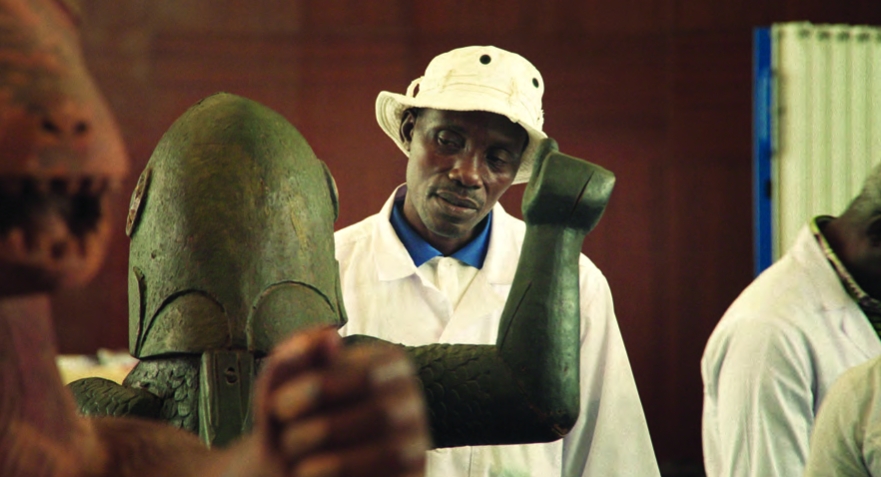
A scene from “Dahomey” written and directed by Mati Diop.For years, art museums and their critics have discussed repatriation. In the art world, repatriation is the act of returning controversially acquired artifacts to their home countries. “Controversially acquired” is really a euphemism for stolen and looted art typically acquired during times of conflict like war and colonization.
French-Senegalese writer and director Mati Diop (“Atlantics”), documents the repatriation process of 26 royal treasures originally from the Kingdom of Dahomey. Temporarily housed in Paris’ Quai Branly Museum, she films their journey from France to Cotonou, Benin, in West Africa in her self-described fantasy-documentary, “Dahomey.”
“Dahomey” follows the transport of 26 statues across the Atlantic Ocean over two years, from 2021 to 2023. The hour-long documentary delicately captures the packaging and shipment of the statues in Paris, their arrival in Benin and the tension that follows housing objects in a country that has modernized without them. Diop records a passionate conversation among students at the University of Abomey-Calavi about the relevance and purpose of repatriation. They discuss the importance of material culture, memory and if there’s room in modern-day Cotonou to acknowledge and embrace the past.
In
2017, French President Emmanuel Macron made an announcement in
Ouagadougou, Burkina Faso, about repatriating African artifacts from
France to their countries of origin. In an English translation of a
speech provided by Macron’s office, he announced, “I cannot accept that a
large share of several African countries’ cultural heritage be kept in
France. There are historical explanations for it, but there is no valid,
lasting and unconditional justification.” He added, “Within five years I
want the conditions to exist for temporary or permanent returns of
African heritage to Africa.”
For
the fantasy aspect of the film, Diop gives a literal voice to the
treasures in the documentary. Working with Haitian author Makenzy Orcel,
Diop vocalizes the inner dialogue of the treasures using voice-overs in
Fon, the language of the largest ethnic group in Benin. She articulates
what it’s like to be stolen from one’s homeland; what it’s like to
adjust to a new home in the West; and what it’s like to return to a land
that used to feel like home but doesn’t anymore.
When
discussing the possibility of repatriating African artifacts in her
lifetime Diop said, “I sadly realized that I had never imagined the
possibility of something like that happening in my lifetime, perhaps out
of resignation. I had never imagined what restitution might actually
look like, and while trying to visualize it, a film was already
crystallizing in my mind.”
On
the surface the film’s focus is on the restoration, restitution and
repatriation of stolen objects. It is also an exploration of the
experiences and the psychology of people caught between two
worlds—Western Africa
and France. The treasures were made in the image of Dahomey’s deities,
rooted in ancient tradition. Now, the treasures are unsettled and
working through their own realities of the modern-day exchange between
Benin and France. The statues and the Beninise are processing
restitution together as museum-goers engage with the art and while
remembering their past and embracing their present.
In this genre-bending film, art imitates life.
“Dahomey”
is the winner of the 2024 Golden Bear from the Berlin International
Film Festival. It is screening at the Museum of Fine Arts, Boston on
December 1.
ON THE WEB
For information and tickets visit mfa.org/event/film/dahomey